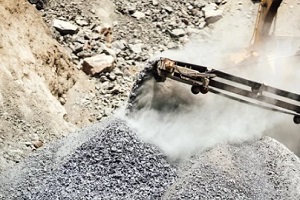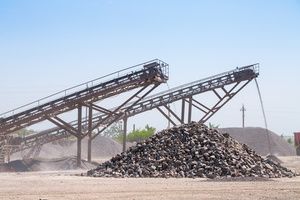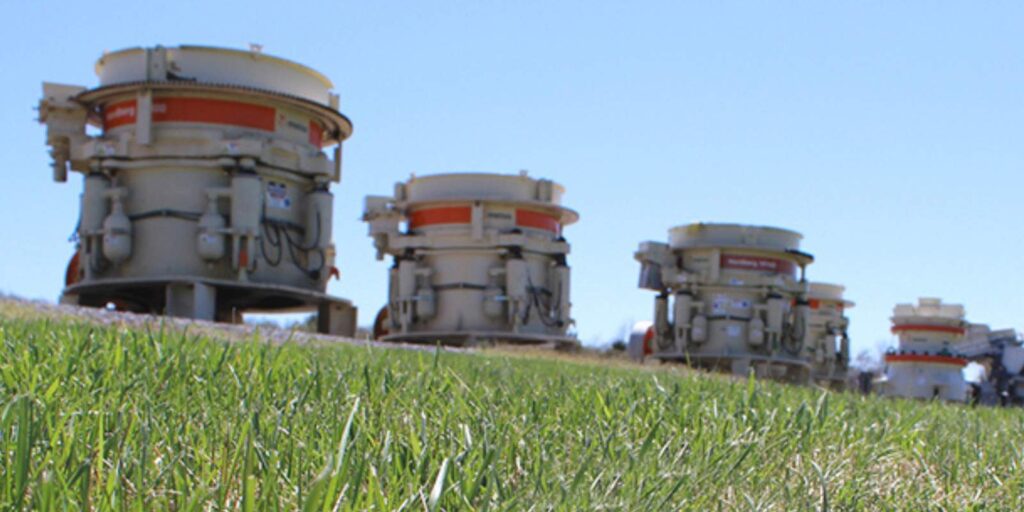Proper sizing and selection of cone crushers are essential to maximize productivity and efficiency in aggregate and mining operations. Cone crushers are indispensable crushing machines, but their output capacity depends heavily on making the right design choices. Here are some factors to consider:
Consider The Type Of Material For Crushing
 The first step is determining the type of material you need to crush. This includes properties such as hardness, abrasiveness, and moisture content. Harder and more abrasive rocks, such as granite, require heavier-duty cone crushers compared to softer rocks, such as limestone.
The first step is determining the type of material you need to crush. This includes properties such as hardness, abrasiveness, and moisture content. Harder and more abrasive rocks, such as granite, require heavier-duty cone crushers compared to softer rocks, such as limestone.
High moisture content material tends to clog cone crushers faster. Therefore, you may need to use pre-screening and scalping to remove any wet fines before crushing. Evaluate your feed material characteristics before choosing a cone crusher.
Specify The Desired Product Shape & Size
What is the desired output you need from the cone crusher? The final product size and shape requirements will influence crusher selection. Cone crushers can efficiently produce fine and coarse particle sizes with good shape, making them suitable for aggregate production.
Be sure to specify the minimum and maximum sizes needed along with the desired particle shape – whether cubic or flat. Cubic particles are typically preferred for asphalt mixes and concrete production.
Determine The Production Capacity Needs
One of the most critical factors in cone crusher selection is the throughput capacity you need for your production objectives. Specify the metric tons per hour you need to produce and choose a crusher sized for that capacity. Undersized crushers will limit throughput, while oversized units are more expensive upfront.
The greater the closed-side setting range, the more flexibility you have to adjust output. Consider whether you need a unit tuned for high volume or optimized for increased reduction ratios. High-capacity crushers have a lower reduction than slower speed but higher compression crushers.
Know The Maximum Feed Size For Crushing
You cannot exceed the maximum allowable feed size for the cone crusher model. The feed size will depend on factors such as the closed side setting, eccentric throw, and head diameter. Exceeding the max feed size will lead to premature crusher failure.
Use the minimum CSS and throw to determine the largest feed material allowable. Anything over this size could cause rotor stalling and damage to internal parts. Carefully screen out oversized rocks using a grizzly system before the material enters the cone crusher.
Select The Right Chamber Profile
 Cone crushers utilize a variety of chamber profiles suited to fine, medium or coarse crushing applications. Fine crushing chambers have a steep head angle with a short crushing stroke. Coarse chambers use a flatter angle and increased stroke for higher throughput. Match the chamber design to the feed material for optimum crushing efficiency. Using rock-on-rock compression, chambers with the right profile consistently produce well-shaped products over a wide range of feed sizes. Choose the chamber that best handles your specific feed material and product requirements.
Cone crushers utilize a variety of chamber profiles suited to fine, medium or coarse crushing applications. Fine crushing chambers have a steep head angle with a short crushing stroke. Coarse chambers use a flatter angle and increased stroke for higher throughput. Match the chamber design to the feed material for optimum crushing efficiency. Using rock-on-rock compression, chambers with the right profile consistently produce well-shaped products over a wide range of feed sizes. Choose the chamber that best handles your specific feed material and product requirements.
Optimize The Crushing Stroke
The crushing stroke is the distance the cone head travels during the crushing cycle. You can optimize throughput capacity and reduction ratios by adjusting the stroke. Shorter stroke settings allow more strokes per minute for increased production.
Longer stroke lengths raise the reduction ratios when more crushing force is needed for hard ores and rocks. Ensure the stroke length is properly set for the particular application based on capacity or reduction needs. An optimal stroke helps maintain interparticle crushing for a consistent high-quality end product.
Consider The Diameter OfThe Cone Head
Larger cone head diameters allow greater throughput capacity because the feed moves quicker through a larger crushing area. Before increasing diameter, ensure the rest of the circuit can handle the added capacity.
Avoid exceeding manufacturer limitations on maximum feed opening based on the head diameter. This will overload the motor and can result in crusher damage over time. While a larger head diameter favors capacity, reduction capability may be sacrificed. Find the optimal balance based on your circuit.
Right-Size The Drive Motor
The drive motor directly contributes to crushing capacity. This is rated based on horsepower and must be powerful enough to match the crushing application. Insufficient motor size leads to stalled crushing and uneven liner wear over time. Oversized motors add unnecessary costs.
Utilize motor power efficiently by operating at 75-95% of total available power. This maximizes throughput while allowing some reserve for occasional overloads. Power draw above 100% risks permanent damage. Carefully select and operate the right motor size for optimal crushing performance.
Balance Throughput & Reduction Ratio
Sometimes production capacity needs to be given priority over reduction ratios and vice versa. You can optimize for one over the other by adjusting certain cone crusher parameters.
For maximizing capacity, use a flatter crushing chamber, larger head diameter, faster eccentric speeds, and shorter stroke settings. If reduction ratios are more important, opt for steeper crushing chambers, slower speeds, and increased stroke length to yield finer products. Often a balance is required to satisfy both targets.
Utilize Automation Features
Modern cone crushers incorporate advanced automation for real-time performance monitoring and automatic adjustment. This protects the crusher while maintaining high capacity.
For example, automated wear compensation tracks liner wear and adjusts settings to maintain consistent capacity. Overload protection systems help prevent damage when tramp material enters the chamber. Enabling automation delivers consistent, predictable output with less human intervention required.
Properly Size Your Cone Crusher With Mellott
With so many factors impacting cone crusher selection and performance, it can be challenging to maximize productivity without expertise. Improperly sized or selected crushers lead to increased downtime, higher operating costs, and uneven wear. You may know the basics of cone crushing but lack the years of hands-on experience needed to fine-tune your machine.
Working with a knowledgeable crushing equipment specialist is invaluable to explore all options and ensure you get a crusher sized for your specific needs. Mellott has the expertise to properly size and select the optimal cone crushers for your purposes. Contact us today at 888.621.8533 or online to discuss how we can maximize your cone-crushing productivity.

